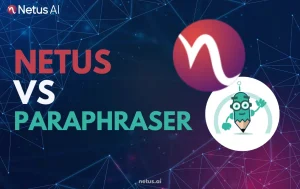
Netus vs. HumanizeAI | Netus.ai
Netus.ai vs. HumanizeAI: Which tool excels in AI bypassing, human-like rewriting or academic reliability? Dive into this detailed breakdown comparing features, accuracy or use cases.
The Dangers of Plagiarism and Strategies to Prevent It: A Comprehensive Guide

Content writer and editor for Netus.AI
The Dangers of Plagiarism and Strategies to Prevent It. Plagiarism is a significant concern for writers, scholars, and students alike, as it undermines the integrity of academic and professional work. Ensuring that content is free from plagiarism is crucial to maintaining ethical standards in writing and fostering intellectual growth. In this article, we will explore the dangers associated with plagiarism and the measures one can take to avoid committing this dishonest act.
Recognizing the importance of producing original content and being aware of the potential consequences of plagiarism are vital for keeping one’s work authentic and valuable. By understanding the risks involved and employing strategies to prevent plagiarism, writers can contribute to a culture that values academic sincerity and the advancement of knowledge.
Plagiarism is akin to kidnapping in the sense that it steals someone’s work and presents it as one’s own. This dishonest act can have severe consequences, especially in the academic world. When someone is caught plagiarizing, their credibility and trustworthiness are jeopardized, both among professors and peers. This tarnished reputation can have a lasting impact on one’s academic and professional career.
Moreover, plagiarizing intentionally or unintentionally can lead to legal issues. Copyright laws protect intellectual property and prohibit unauthorized use of someone else’s work. If caught violating these laws, the plagiarizer may face criminal charges. To avoid these risks, it’s essential to give proper credit to the original author or creator when using their material.
In summary, plagiarism is a serious ethical issue that can jeopardize one’s academic and professional integrity. By understanding the risks associated with plagiarizing content and respecting intellectual property rights, individuals can prevent the negative consequences associated with this act. Remember that honesty and transparency are crucial in maintaining a good reputation and building trust in any field
To effectively avoid plagiarism, it is essential to develop specific habits and follow guidelines that ensure the proper use of sources, paraphrasing, citations, and quotations.
Starting early on assignments is a beneficial habit, as it allows ample time to delve into ideas and reduces the risk of making mistakes under pressure. Properly citing all sources used in your work is crucial – be sure to familiarize yourself with citation standards and apply them consistently.
Incorporating quotations from sources is a straightforward way to give credit and avoid plagiarism. It is recommended to include quotations as you draft your paper so potential plagiarism issues can be addressed proactively.
Another effective method is paraphrasing, rewording a source’s information while retaining its meaning. Adding your unique insights and ideas to the paraphrased text improves comprehension, demonstrates your understanding of the subject, and further safeguards against plagiarism.
Techniques to avoid plagiarism:
Adding value to your writing, such as including your insights, not only helps to avoid plagiarism but enhances the quality of your work, reflecting a deeper understanding of the topic.
Utilizing plagiarism checkers like Copyleaks can be a valuable tool in ensuring your writing is original. These platforms can quickly compare your text to other works and identify any potential issues.
Teachers can be a helpful resource for understanding the requirements of citing and quoting for your assignment, guiding you through the writing process without falling into plagiarism traps.
When using online information, remember that it is also considered a source. Therefore, including references for websites, articles, and papers is necessary to avoid plagiarizing.
By following these practices and maintaining a confident, knowledgeable, neutral, and clear tone of voice, you can successfully avoid plagiarism while creating meaningful, original work that showcases your insights.
Accidental plagiarism occurs when a person unknowingly paraphrases or uses someone else’s ideas in their work. This can often happen when students are under pressure to complete assignments or while collaborating with peers. It is important to understand that even unintentional verbatim copying can lead to consequences. This type of plagiarism can stem from a lack of understanding of the subject or context along with insufficient preparation.
To prevent accidental plagiarism, be sure to thoroughly comprehend the material and the overall concept before attempting to write or paraphrase it. Here are some suggestions to help avoid accidental plagiarism:
By following these guidelines, students can maintain academic integrity and avoid the pitfalls of accidental plagiarism while confidently presenting their own work.
To effectively prevent plagiarism, it is crucial to follow these guidelines:
By following these steps and using tools like plagiarism checkers and attending workshops or peer reviews, you can ensure that your work is original and free of plagiarism while simultaneously showcasing your knowledge and understanding of the topic.
Avoiding plagiarism is crucial in maintaining a reputable academic standing and preserving one’s career. Here are some suggestions to help you sidestep plagiarism and ensure the integrity of your work, regardless of your academic or professional level.
To summarize, steering clear of plagiarism requires dedication, research, and comprehension. By adhering to these principles and consistently producing original content, you will ensure the integrity of your academic journey and elevate your standing in the academic and professional world.
Long-term repercussions of plagiarism for students in academic settings include:
To properly attribute sources and prevent plagiarism, students should:
Some effective technological tools to detect and prevent plagiarism include:
These tools compare submitted work with existing content to identify matching text, helping students and educators ensure originality.
Plagiarism undermines the integrity of academic research by:
Educators can facilitate intellectual property rights understanding by:
The professional consequences of plagiarism include:

Netus.ai vs. HumanizeAI: Which tool excels in AI bypassing, human-like rewriting or academic reliability? Dive into this detailed breakdown comparing features, accuracy or use cases.

Netus.ai vs. BypassAI: Which tool excels in AI bypassing, human-like rewriting or academic reliability? Dive into this detailed breakdown comparing features, accuracy or use cases.

Netus.ai vs. AIUndetect: Which tool excels in AI bypassing, human-like rewriting or academic reliability? Dive into this detailed breakdown comparing features, accuracy or use cases.

Netus.ai vs. AIUndetect: Which tool excels in AI bypassing, human-like rewriting or academic reliability? Dive into this detailed breakdown comparing features, accuracy or use cases.

Netus.ai vs. Paraphraser: Which tool excels in AI bypassing, human-like rewriting or academic reliability? Dive into this detailed breakdown comparing features, accuracy or use cases.

Netus.ai vs. Smodin: Which tool excels in AI bypassing, human-like rewriting or academic reliability? Dive into this detailed breakdown comparing features, accuracy or use cases.
@ 2024 Netus AI.